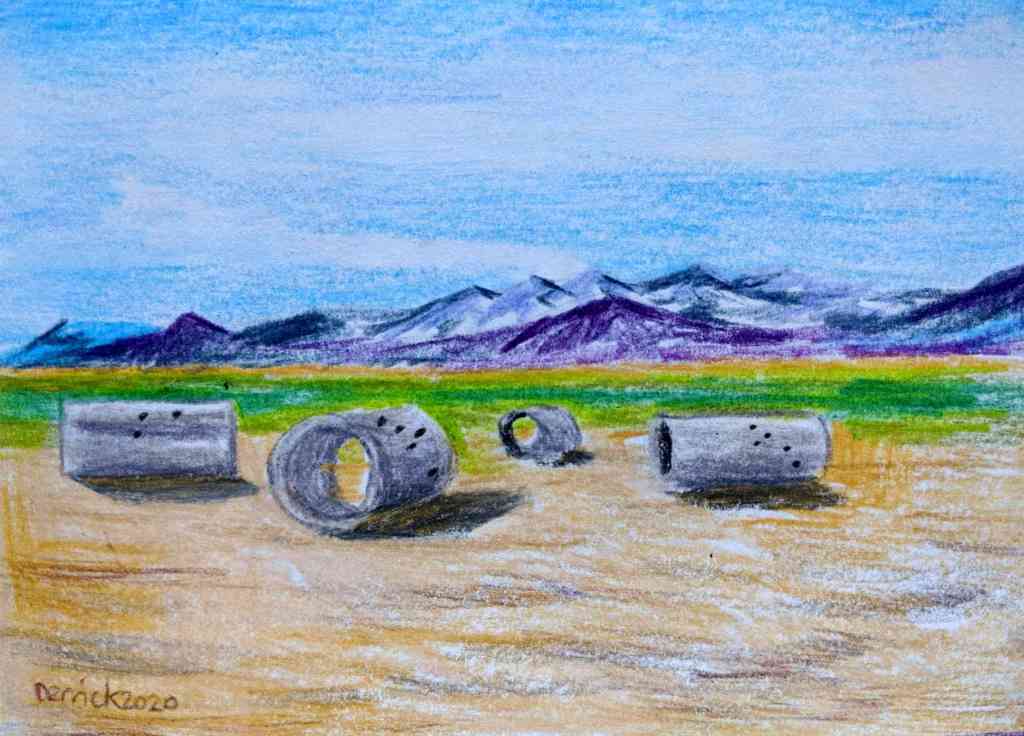In 1976, sculptor and filmmaker Nancy Holt (1938-2014) completed her most iconic work. Sun Tunnels, an arrangement of 4 huge concrete tunnels positioned in the middle of Utah’s Great Basin Desert, was ready for display. This amazing artwork is considered to be one of the best and most famous examples of land art.

About Nancy Holt’s Sun Tunnels
The sun tunnels, arranged in a complementary cross-shape, are laid out on the cracked desert floor. Each tunnel is 5.5 metres (18 feet) long, and 2.7 metres (9 feet) in diameter, making it easy to walk around inside each one. The entire sculpture is 26 metres (86 feet) in diameter.
Each tunnel is positioned to react to the sun in different ways. The tunnels align with sunrises and sunsets for the winter and summer solstice. What’s more, holes carefully drilled through each tunnel form the shapes of the constellations Draco, Perseus, Columba, and Capricorn, which are projected as rays of sun onto the interior of each tunnel.
It took three years of planning to arrange this masterpiece, and while the concept seems relatively straightforward, creating this artwork required the expertise of engineers, astrologers, crane teams, and contractors. Indeed, Holt even produced a film depicting the construction of Sun Tunnels.
Part of experiencing Sun Tunnels is about the journey to get out to the middle of nowhere. On a basic level, the tunnels offer some shade from the desert heat inside the concrete structures. Some even choose to sleep inside, to wake early and catch the first colourful effects of the sunrise in the tunnels.
Against the stark backdrop of the Utah desert, the sun is the most amazing feature through the lenses that Holt has built. As Holt herself said of Sun Tunnels, the tunnels “bring the vast space of the desert back to human scale.”

Conservation of the Sun Tunnels
In 2019, efforts to conserve Sun Tunnels began. As an inevitable consequence of being land art, cracking and erosion have taken their toll on the structures due to the extreme conditions of the desert heat. The Dia Art Foundation based in New York acquired Sun Tunnels in 2018 (as well as the work of Holt’s husband Robert Smithson, Spiral Jetty).
According to Lisa Le Feuvre, the executive director of the Holt/Smithson Foundation, “Nancy Holt’s Sun Tunnels is landmark earthwork that is central to the future of art history. . . .This conservation of Sun Tunnels is emblematic of Dia’s undertaking to enable long-term and direct experience of artworks that have built the ground of art today.”
The conservation project will also include removal of graffiti left on the tunnels. The Dia Art Foundation also requests that visitors not make fire pits, and remove their garbage when they leave.
Visiting Nancy Holt’s Sun Tunnels
Sub Tunnels is about 4 hours drive from Salt Lake City. The closest town is Lucin, a ghost town with no remaining buildings. However, street signs towards Lucin remain. There are no facilities at Sun Tunnels, such as bathrooms, food, water, or fuel. The closest place for these facilities are at Montello, Nevada (45 minutes from the site).